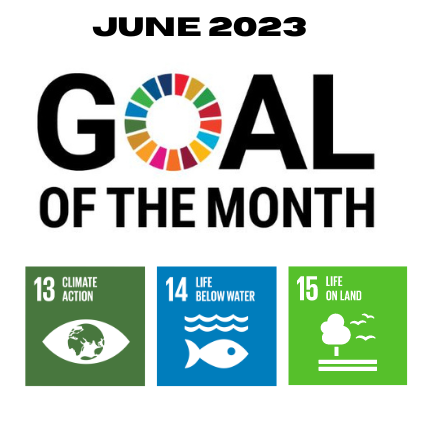


This June we are dedicating special attention to the environment, specifically SDG 13: Climate Action, SDG 14: Life on Land, and SDG 15: Life Below Water
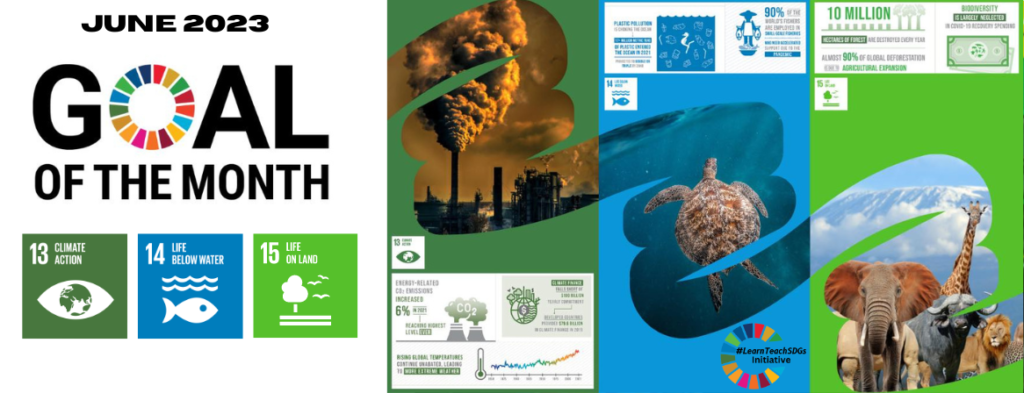
As we focus on SDG 13, SDG 14, and SDG 15, we are reminded of the interconnectedness of environmental issues and the urgent need for collective action to ensure a sustainable future for all. By addressing climate change, protecting marine ecosystems, and preserving terrestrial biodiversity, we can strive toward a more resilient planet for generations to come.

SDG 13: Take urgent action to combat climate change and its impacts and call for urgent climate action, urging us to reduce greenhouse gas emissions and adapt to the impacts of climate change. It’s time we prioritize sustainable practices and make a positive impact on our environment.
The global temperature has already risen 1.1ºC above the pre-industrial level, with glaciers melting and the sea level rising. The impacts of climate change also include flooding and drought, displacing millions of people, sinking them into poverty and hunger, denying them access to basic services, such as health and education, expanding inequalities, stifling economic growth and even causing conflict. By 2030, an estimated 700 million people will be at risk of displacement by drought alone.
Taking urgent action to combat climate change and its devastating impacts is, therefore, an imperative to save lives and livelihoods, and key to making the 2030 Agenda for Sustainable Development and its 17 Goals – the blueprint for a better future – a reality.
In 2020, concentrations of global greenhouse gases reached new highs, and real-time data point to continued increases. As these concentrations rise, so does the Earth’s temperature. In 2021, the global mean temperature was about 1.1°C above the pre-industrial level (from 1850 to 1900). The years from 2015 to 2021 were the seven warmest on record.
To limit warming to 1.5° Celsius above pre-industrial levels, as set out in the Paris Agreement, global greenhouse gas emissions will need to peak before 2025. Then they must decline by 43 percent by 2030 and to net zero by 2050. Countries are articulating climate action plans to cut emissions and adapt to climate impacts through nationally determined contributions. However, current national commitments are not sufficient to meet the 1.5°C target.
SDG 13: Facts and figures
*In 2021, the global mean temperature was about 1.1°C above the pre-industrial level (from 1850 to 1900). The years from 2015 to 2021 were the seven warmest on record.
*The global annual mean temperature is projected to rise beyond 1.5°C above pre-industrial levels in at least one of the next five years.
*Global carbon dioxide (CO2) emissions declined by 5.2 percent in 2020 due to lowered energy demand caused by COVID-19-induced social and economic disruptions. But with the phasing out of COVID-related restrictions, energy-related CO2 emissions for 2021 rose by 6 percent, reaching their highest level ever.
*Climate finance provided and mobilized by developed countries totaled $79.6 billion in 2019, up from $78.3 billion in 2018. It is estimated that $1.6 trillion to $3.8 trillion will be needed each year through 2050 for the world to transition to a low-carbon future and avoid warming exceeding 1.5 °
*About one-third of global land areas will suffer at least moderate drought by 2100.
*The sea level could rise 30 to 60 centimeters by 2100, even if greenhouse gas emissions are sharply reduced and global warming is limited to well below 2°C.
*About 70 to 90 percent of warm-water coral reefs will disappear even if the 1.5°C threshold is reached; they would die off completely at the 2°C level.
*3 billion to 3.6 billion people live in contexts that are highly vulnerable to climate change.
*By 2030, an estimated 700 million people will be at risk of displacement by drought alone
SDG 13 targets
13.1 Strengthen resilience and adaptive capacity to climate-related hazards and natural disasters in all countries
13.2 Integrate climate change measures into national policies, strategies, and planning
13.3 Improve education, awareness-raising, and human and institutional capacity on climate change mitigation, adaptation, impact reduction, and early warning
13.A Implement the commitment undertaken by developed-country parties to the United Nations Framework Convention on Climate Change to a goal of mobilizing jointly $100 billion annually by 2020 from all sources to address the needs of developing countries in the context of meaningful mitigation actions and transparency on implementation and fully operationalize the Green Climate Fund through its capitalization as soon as possible
13.B Promote mechanisms for raising capacity for effective climate change-related planning and management in the least developed countries and small island developing States, including focusing on women, youth, and local and marginalized communities
*Acknowledging that the United Nations Framework Convention on Climate Change is the primary international, intergovernmental forum for negotiating the global response to climate change.
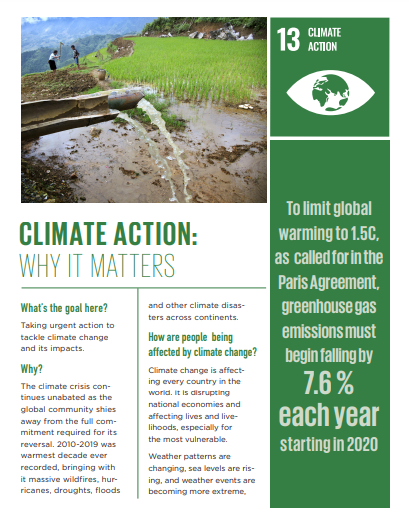
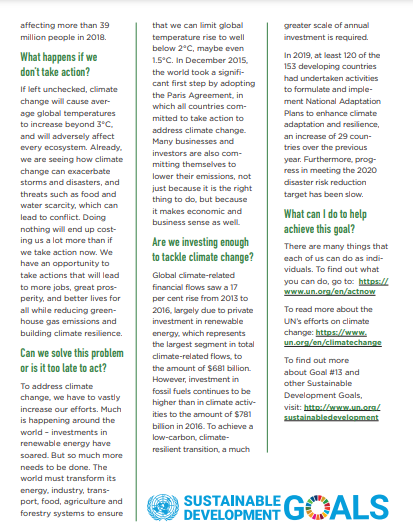
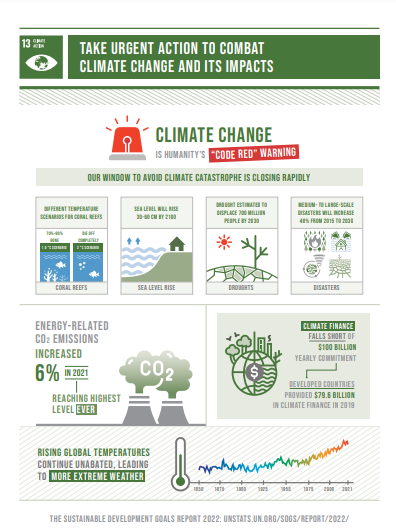

SDG 14 (life below water) emphasizes the significance of our oceans, seas, and marine life. Protecting marine ecosystems, reducing pollution, and promoting sustainable fishing practices are essential to preserving the beauty and diversity of life below water.
SDG 14 is about conserving and sustainably using the oceans, seas, and marine resources. Healthy oceans and seas are essential to human existence and life on Earth. They cover 70 percent of the planet and provide food, energy, and water. The ocean absorbs around one-quarter of the world’s annual carbon dioxide (CO2) emissions, thereby mitigating climate change and alleviating its impacts.
It is essential to conserve and sustainably use them. Yet, human activity is endangering the oceans and seas – the planet’s largest ecosystem – and affecting the livelihoods of billions of people.
SDG 14 Facts and figures
*Continuing ocean acidification and rising ocean temperatures are threatening marine species and negatively affecting marine ecosystem services. Between 2009 and 2018, the world lost about 14 percent of coral reefs.
*In 2021, more than 17 million metric tons of plastic entered the world’s oceans, making up 85 percent of marine litter. The volume of plastic pollution entering the ocean each year is expected to double or triple by 2040.
*The global coverage of marine protected areas stood at 8 percent of global coastal waters and oceans in 2021.
*More than a third (35.4 percent) of global fish stocks were overfished in 2019, up from 34.2 percent in 2017 and 10 percent in 1974. However, the rate of decline has recently slowed.
*Almost half a billion people depend at least partially on small-scale fisheries, which account for 90 percent of employment in fisheries worldwide.
SDG 14 targets
14.1 By 2025, prevent and significantly reduce marine pollution of all kinds, in particular from land-based activities, including marine debris and nutrient pollution
14.2 By 2020, sustainably manage and protect marine and coastal ecosystems to avoid significant adverse impacts, including by strengthening their resilience, and taking action for their restoration in order to achieve healthy and productive oceans
14.3 Minimize and address the impacts of ocean acidification, including through enhanced scientific cooperation at all levels
14.4 By 2020, effectively regulate harvesting and end overfishing, illegal, unreported, and unregulated fishing, and destructive fishing practices and implement science-based management plans, in order to restore fish stocks in the shortest time feasible, at least to levels that can produce maximum sustainable yield as determined by their biological characteristics
14.5 By 2020, conserve at least 10 percent of coastal and marine areas, consistent with national and international law and based on the best available scientific information
14.6 By 2020, prohibit certain forms of fisheries subsidies that contribute to overcapacity and overfishing, eliminate subsidies that contribute to illegal, unreported, and unregulated fishing and refrain from introducing new such subsidies, recognizing that appropriate and effective special and differential treatment for developing and least developed countries should be an integral part of the World Trade Organization fisheries subsidies negotiation
14.7 By 2030, increase the economic benefits to Small Island developing States and least developed countries from the sustainable use of marine resources, including through sustainable management of fisheries, aquaculture, and tourism
14.A Increase scientific knowledge, develop research capacity, and transfer marine technology, taking into account the Intergovernmental Oceanographic Commission Criteria and Guidelines on the Transfer of Marine Technology, in order to improve ocean health and to enhance the contribution of marine biodiversity to the development of developing countries, in particular, small island developing States and least developed countries
14.B Provide access for small-scale artisanal fishers to marine resources and markets
14.C Enhance the conservation and sustainable use of oceans and their resources by implementing international law as reflected in UNCLOS, which provides the legal framework for the conservation and sustainable use of oceans and their resources, as recalled in paragraph 158 of The Future We Want
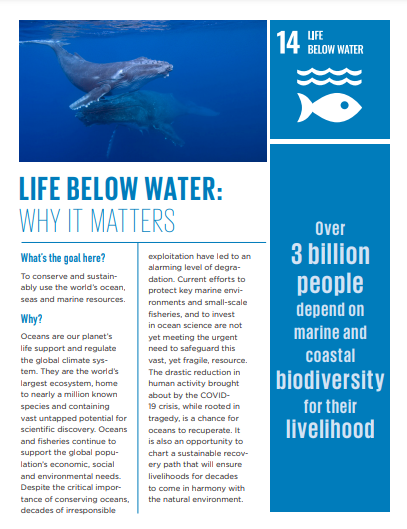

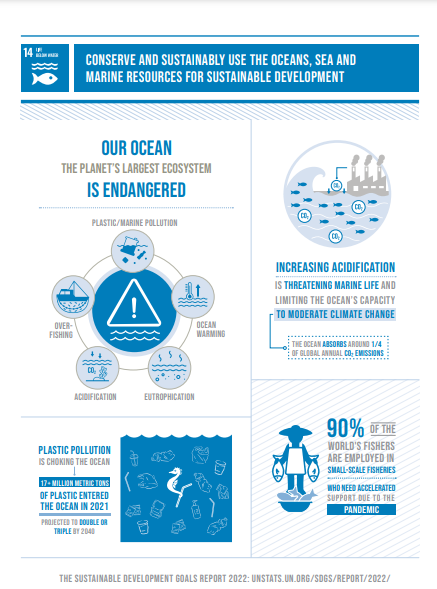

SDG 15 (life on land) highlights the need to conserve and restore terrestrial ecosystems. Let’s safeguard our forests, protect wildlife habitats, and combat land degradation. Together, we can create a healthier planet
SDG 15 is about conserving life on land. It is to protect and restore terrestrial ecosystems, sustainably manage forests, combat desertification, halt and reverse land degradation and stop biodiversity loss. Healthy ecosystems and the biological diversity they support are a source of food, water, medicine, shelter, and other material goods. They also provide ecosystem services – the cleaning of air and water – which sustain life and increase resiliency in the face of mounting pressures.
Nevertheless, human activities have profoundly altered most terrestrial ecosystems: around 40,000 species are documented to be at risk of extinction over the coming decades, 10 million hectares of forest (an area the size of Iceland) are being destroyed each year, and more than half of key biodiversity areas remain unprotected.
Facts and Figures
*Forest cover fell from 31.9 percent of total land area in 2000 to 31.2 percent in 2020, a net loss of almost 100 million hectares.
*Agricultural expansion is driving almost 90 percent of global deforestation, including 49.6 percent from expansion for cropland and 38.5 percent for livestock grazing.
*Between 2010 and 2021, the area of forest land under certification schemes increased by 35 percent. The proportion of forests under a long-term management plan increased from 54 percent in 2010 to 58 percent in 2020.
*More than 700 million hectares of forest (18 percent) were in legally established protected areas in 2020.
*Human activities such as logging and farming are encroaching upon habitats, putting about 20 percent of reptile species at risk.
*Globally, the mean percentage coverage of key biodiversity areas increased from over one quarter in 2000 to nearly one-half in 2021.
*More and more countries are establishing national targets for incorporating ecosystem and biodiversity values into their accounting and reporting systems. By January 2022, 37 percent of countries assessed are on track to achieve or exceed their national targets.
Goal 15 targets
15.1 By 2020, ensure the conservation, restoration, and sustainable use of terrestrial and inland freshwater ecosystems and their services, in particular forests, wetlands, mountains, and drylands, in line with obligations under international agreements
15.2 By 2020, promote the implementation of sustainable management of all types of forests, halt deforestation, restore degraded forests and substantially increase afforestation and reforestation globally
15.3 By 2030, combat desertification, restore degraded land and soil, including land affected by desertification, drought, and floods, and strive to achieve a land degradation-neutral world
15.4 By 2030, ensure the conservation of mountain ecosystems, including their biodiversity, in order to enhance their capacity to provide benefits that are essential for sustainable development
15.5 Take urgent and significant action to reduce the degradation of natural habitats, halt the loss of biodiversity and, by 2020, protect and prevent the extinction of threatened species
15.6 Promote fair and equitable sharing of the benefits arising from the utilization of genetic resources and promote appropriate access to such resources, as internationally agreed
15.7 Take urgent action to end poaching and trafficking of protected species of flora and fauna and address both the demand and supply of illegal wildlife products
15.8 By 2020, introduce measures to prevent the introduction and significantly reduce the impact of invasive alien species on land and water ecosystems and control or eradicate the priority species
15.9 By 2020, integrate ecosystem and biodiversity values into national and local planning, development processes, poverty reduction strategies, and accounts
15.A Mobilize and significantly increase financial resources from all sources to conserve and sustainably use biodiversity and ecosystems
15.B Mobilize significant resources from all sources and at all levels to finance sustainable forest management and provide adequate incentives to developing countries to advance such management, including for conservation and reforestation
15.C Enhance global support for efforts to combat poaching and trafficking of protected species, including by increasing the capacity of local communities to pursue sustainable livelihood opportunities



Source: The Sustainable Development Goals Report 2022
2022 Progress toward the SDGs, Goal # 13 Climate Action
2022 Progress toward the SDGs, Goal #14 Life Below Water







